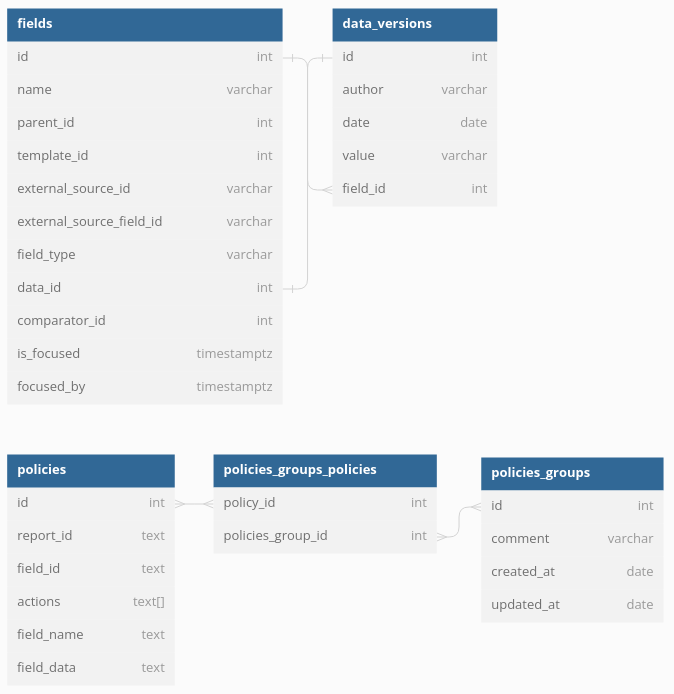Developer's guide Database schema
28 mai 2024 à 05:35Database schema

Note
This database schema doesn’t really represent what has been implemented in the database.
In the fields table, external_source_id, external_source_field_id, comparator_id, are never used as for now.
Here are the details of what they were planned for:
- external_source_id (varchar(50)) : external source id defined in the configuration file. Example :
graf. Is defined on fields of type template. - external_source_field_id (varchar(50)) : field id of the field to be imported from the external source. Is defined on fields of type template.
- comparator_id (int) : Only if the field_type =
quantitative_addition_comparedorquantitative_average_comparedin order to indicate another field’s id with which to compare the value. Used to compare the value of a quantitative field with the value of anobjectivefield.
And is_focused, focused_by columns are not even currently present in the database. They were planned to manage realtime collaboration in order to lock fields when focused and to register who is writing on them.
Note concerning data_versions
data_versions table has been created to manage fields versions and to allow rollbacks and other historical functions.
However as for now, field versioning has not been implemented.
This data_versions table only adds a layer of complexity without any benefits comparing to a simple value column in the fields table.
It has been implemented from the beginning in order to prevent a future data migration.
Dbdiagram.io syntax
Here below you can see the syntax interpreted by dbdiagram.io to generate the upper schema.
Table fields {
id int
name varchar
parent_id int
template_id int
external_source_id varchar
external_source_field_id varchar
field_type varchar
data_id int
comparator_id int
is_focused timestamptz
focused_by timestamptz
}
Table data_versions {
id int
author varchar
date date
value varchar
field_id int
}
Table policies_groups {
id int
comment varchar
created_at date
updated_at date
}
Table policies_groups_policies {
policy_id int
policies_group_id int
}
Table policies {
id int
report_id text
field_id text
actions text[]
field_name text
field_data text
}
// Creating references
// You can also define relaionship separately
// > many-to-one; < one-to-many; - one-to-one; <> many-to-many
Ref: fields.data_id - data_versions.id
Ref: data_versions.field_id > fields.id
Ref: policies_groups_policies.policy_id <> policies.id
Ref: policies_groups_policies.policies_group_id <> policies_groups.id